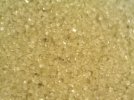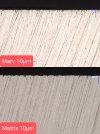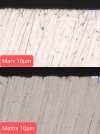I just ran across him and he has a blog kind of similar to Science of Sharp. He works for Kern and has access to a few electron microscopes where he evaluates many stones, stropping emulsions, leather, and makes resin bond diamond stones. Since he sells his stones on his website I don't think I can post the link here, so you will have to search him out yourself. Interesting.
-
The BladeForums.com 2024 Traditional Knife is available! Price is $250 ea (shipped within CONUS).
Order here: https://www.bladeforums.com/help/2024-traditional/
You are using an out of date browser. It may not display this or other websites correctly.
You should upgrade or use an alternative browser.
You should upgrade or use an alternative browser.
Anyone hear of Dr. Marv and his resin bond diamond stones?
- Thread starter Diemaker
- Start date
I own and test stones ranging from 10μm to 0.5μm.
I have had the opportunity to try stones from Nano Hone, Matrix, Jende, Venev, and PDT.
Dr. Marv's Scientific Stones are currently the best available. (Except for the 0.5μm stone, which scratches the perfect edge, and it seems that this is caused more by adhesion than by larger parasitic diamond grains).
I have photos of the edge under a professional microscope, but this is my first post on this forum and I don't know how to upload them here.
I have had the opportunity to try stones from Nano Hone, Matrix, Jende, Venev, and PDT.
Dr. Marv's Scientific Stones are currently the best available. (Except for the 0.5μm stone, which scratches the perfect edge, and it seems that this is caused more by adhesion than by larger parasitic diamond grains).
I have photos of the edge under a professional microscope, but this is my first post on this forum and I don't know how to upload them here.
dantzk8
Basic Member
- Joined
- Nov 1, 2005
- Messages
- 1,951
The post #20 of this thread could interest you:
Dan.
I have all 3 sets - Medium (20 µm, 10 µm, 5 µm), Fine (2.5 µm, 1 µm, 0.5 µm) and now in a Coarse set (80 µm, 60 µm, 40 µm) of a revolutionary new resin bonded diamond technology that produces edges so smooth you have to see to believe. No Scratches. I have sharpened kitchen and folders from Rex121 to D2 to stainless Henckels with Bess edges down to 25. I can’t recommend these stones highly enough. The resin bond...Remember that diamonds scratch much deeper than their waterstone counterparts.
Dan.
Thanks for that. This certainly has my interest. I am very curious to try them out myself as the declarations about how well they work are outside of my experience.The post #20 of this thread could interest you:
I have all 3 sets - Medium (20 µm, 10 µm, 5 µm), Fine (2.5 µm, 1 µm, 0.5 µm) and now in a Coarse set (80 µm, 60 µm, 40 µm) of a revolutionary new resin bonded diamond technology that produces edges so smooth you have to see to believe. No Scratches. I have sharpened kitchen and folders from Rex121 to D2 to stainless Henckels with Bess edges down to 25. I can’t recommend these stones highly enough. The resin bond...Remember that diamonds scratch much deeper than their waterstone counterparts.
Dan.
It may be that you are new without enough posts to be able to post photos. For me there is a picture icon 5th from the right at the top to insert images. Are these pictures you took or from Dr. Marvin? If you took them and want to email them to me I would be happy to post them. My address is david and the rest is cgsw.us I am currious how much they wear, how do you dress them, and how often do you dress them? I am keenly aware of the compromises that are juggled and high diamond loadings have lead to increased wear rates in my experience. Of course I am most curious about the resin.I own and test stones ranging from 10μm to 0.5μm.
I have had the opportunity to try stones from Nano Hone, Matrix, Jende, Venev, and PDT.
Dr. Marv's Scientific Stones are currently the best available. (Except for the 0.5μm stone, which scratches the perfect edge, and it seems that this is caused more by adhesion than by larger parasitic diamond grains).
I have photos of the edge under a professional microscope, but this is my first post on this forum and I don't know how to upload them here.
I know Dr. Marv's are touted as a higher diamond concentration so I just want to post a photo of a 40 micron, 450 grit, Matrix stone for comparison to the one in post #20 that was linked. From the scale on that photo I think those are 40 micron diamonds. I do have 2 sample sets of Matrix stones I made 2 years ago that I put as much diamond in them as possible, as a possible premium version. I will take some photos of them to compare with.
Attachments
-BaRD- emailed me some photos he took with his fabulous microscope and we emailed a bit yesterday. He asked me to post the first three to show the scale of magnification, that is a human hair, and the rest are up to me. I am only showing Dr. Marv's stones to stick with the post topic. They are impressive, but I have lots of few questions, the biggest is how they avoid contamination with these fine grits as I see no evidence of any. I only have them in 2.5, 1, and .5 micron stones used and limited it to Maxamet for consistency. As for the issues with the .5 micron stones, I can't get anything finer than 3 microns to improve the polish on Maxamet, so I find this very impressive. The file names state the steel, abrasive size, and magnification. If you want more let me know. He said he would send me some photos of the 10 micron stone in use on Tuesday, of which I will certainly pass them on here once I get them.
Thank you -BaRD-!
Thank you -BaRD-!
Attachments
-
 Maxamet Dr. Marv 2.5 2500x.jpg265.4 KB · Views: 6
Maxamet Dr. Marv 2.5 2500x.jpg265.4 KB · Views: 6 -
 Maxamet Dr. Marv 2.5 1000x.jpg341.6 KB · Views: 10
Maxamet Dr. Marv 2.5 1000x.jpg341.6 KB · Views: 10 -
 Maxamet Dr. Marv 1 2500x.jpg218.5 KB · Views: 9
Maxamet Dr. Marv 1 2500x.jpg218.5 KB · Views: 9 -
 Maxamet Dr. Marv 1 1000x.jpg301 KB · Views: 11
Maxamet Dr. Marv 1 1000x.jpg301 KB · Views: 11 -
 Maxamet Dr. Marv 0.5 2500x jine svetlo.jpg232.5 KB · Views: 20
Maxamet Dr. Marv 0.5 2500x jine svetlo.jpg232.5 KB · Views: 20 -
 Maxamet Dr. Marv 0.5 1000x.jpg332.6 KB · Views: 10
Maxamet Dr. Marv 0.5 1000x.jpg332.6 KB · Views: 10 -
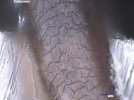 2500 scale.jpg283.2 KB · Views: 16
2500 scale.jpg283.2 KB · Views: 16 -
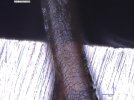 1000 scale.jpg298.6 KB · Views: 10
1000 scale.jpg298.6 KB · Views: 10 -
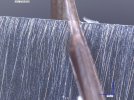 300 scale.jpg438.1 KB · Views: 9
300 scale.jpg438.1 KB · Views: 9
Last edited:
jjg6319
Gold Member
- Joined
- Dec 19, 2011
- Messages
- 974
- Joined
- Jul 16, 2007
- Messages
- 1,099
Interesting! I don't mean to put you on the spot but how do they stack up against your resin bonded diamonds sold through Edge Pro? I have the complete set of Matrix stones and in many ways they're untouchable, head and shoulders above all the other diamonds I've used (not that I've tried them all). Dr Marv's stones are quite expensive so I am curious if they add anything I'm not getting with the Matrix. Thanks!-BaRD- emailed me some photos he took with his fabulous microscope and we emailed a bit yesterday. He asked me to post the first three to show the scale of magnification, that is a human hair, and the rest are up to me. I am only showing Dr. Marv's stones to stick with the post topic. They are impressive, but I have lots of few questions, the biggest is how they avoid contamination with these fine grits as I see no evidence of any. I only have them in 2.5, 1, and .5 micron stones used and limited it to Maxamet for consistency. As for the issues with the .5 micron stones, I can't get anything finer than 3 microns to improve the polish on Maxamet, so I find this very impressive. The file names state the steel, abrasive size, and magnification. If you want more let me know.
You're not putting me on the spot, I am the one that started this thread. I know he is a "competitor" but it looks like he is doing something no one else has done, make resin bond stones that work below 5 microns with diamonds. I know others state their stones have similar size diamonds and work but I don't think this is true. I have tested the Venev Orion 3/2 F1200 stone and the scratch pattern says it is much coarser. I have said many times, don't put too much value in the numbers on your stone, you have to try it out to see how it fits in your grit progression. From what images I have seen, Dr. Marv is making stones that work at significantly finer grits than anyone else, including me, in a stone. I think I can get where he is going, but you have to switch to a strop to do so. Kudos to Dr. Marv! But, I do have many questions and want to try them out myself to see just how they really compare to what I make. I am very curious as to how they are achieving the contamination free scratch pattern with these very fine grits? I had to make my polymer strops to do that, and still the scratch patterns are not perfect, which Dr. Marv's do look perfect. So, a few of my questions;Interesting! I don't mean to put you on the spot but how do they stack up against your resin bonded diamonds sold through Edge Pro? I have the complete set of Matrix stones and in many ways they're untouchable, head and shoulders above all the other diamonds I've used (not that I've tried them all). Dr Marv's stones are quite expensive so I am curious if they add anything I'm not getting with the Matrix. Thanks!
How do they wear? He makes them 3 times thicker than I do, and mine can last a lifetime if used and cared for properly.
How often and how do you dress them?
How fast are they? Not a big one but I have heard they do cut noticeably faster.
It sounds like edge leading passes are used. This leads to a lot of questions.
Dr. Marv tested a Matrix 4000 and did quite a write-up on it. He did this with a lot of stones, kind of like Todd at Science of Sharp, and well worth reading. Please read about the Venev resin bond stones, it explains why they leave more bite than the Matrix stones for the same grit. He has a standard way of using the stones to sharpen a standard blade. In his words "65 HRC M398, and sharpened to 17 DPS with resin bond diamond stones down to 10 µm. Afterwards, the tested stone is used, first in a back and forth movement until the surface becomes homogenous, and then alternating strokes (5-5-3-2) on each side, for a total of 20 strokes towards the apex per side. No pressure is applied but the weight of the apparatus. Then the Pro Matrix stone comes into play. The blade tested at 118 BESS. No stropping was undertaken." I know for a fact that if used correctly, the edge should test in the low 80s, if not the low 70s, with that number of passes and pressure. He used edge leading passes but I don't think that is all that went wrong here.
I am always trying to improve my stones as I do believe there is plenty of room for improvement. I have tried many different resins, both in the same family I use and several other types. The funny thing is the current recipe has been the same for over 20 years. The only changes have been in how I process it, which has changed drastically over the years. I am pretty sure Dr. Marv is using a resin I haven't tried yet, and would love to know what it is. I am sure I will eventually get to try them without having to buy them. I would be glad to trade "kits", and can put together one with not only the standard Matrix stones and accessories, but a full set of the Diamond Max series that didn't go anywhere. I made 2 sets of Matrix stones with the most diamond in them that I could a few years ago. One for EP and one for me. They do cut a little faster but at the expense of wearing much faster. Even if they didn't cost more they would be a lower value than the current Matrix stones so they didn't make it to production. Come to think of it , maybe a higher diamond loading might help a finer grit stone, something below my current 5 micron limit? If nothing else, Dr. Marv is good food for thought, and will hopefully help me improve what I make.
Dr. Marv's blog https://drmarv.com/categories-archive/ Hopefully, this doesn't run afoul of this site's rules on outside links. I am only linking to the knowledge side of his website. You should read about him too.
- Joined
- Jul 16, 2007
- Messages
- 1,099
Thanks! I've found that there are very few product categories where something is ever the "absolute best". Nearly everything is a series of well-chosen compromises. I'm academically interested in super high grits but in practice I rarely use them. I've occasionally found myself wishing the Matrix line had something a bit finer, maybe 8k, but in actual practice the 4k leaves a beautiful polish. My preferred stones for most uses are the Naniwa Chocera but I usually reserve the Matrix stones for steels that are abrasion resistant enough that the Choceras aren't ideal. I was a chef for 25+ years and opened my sharpening shop this year. Primarily I'm concerned with an edge that performs well for the given task first, speed of sharpening second and appearance/polish a distant third. Certainly these stones are interesting and bear some study!
I had a Matrix 10µm stone to test so that I could compare it with a Dr. Marv 10µm stone. The owner of the stone requested that I use only water as a lubricant. Apparently, this is the manufacturer's recommendation. Is this correct?
I used distilled water
The day before, I used ISOPAR H as a lubricant when grinding with the Dr. Marv stone, so the conditions for the stones were not the same.
The surface of the edge was comparable after both stones. The cut was slightly more toothy after Matrix, while it was smoother after Marv.
After grinding, I cleaned both stones with a used electroplated diamond stone.
Matrix was easier to clean because Marv is a little harder.
I sent the microscope photos to Diemaker by email because I can't publish them yet (only http://).
He can post them here if he wants to.
I used distilled water
The day before, I used ISOPAR H as a lubricant when grinding with the Dr. Marv stone, so the conditions for the stones were not the same.
The surface of the edge was comparable after both stones. The cut was slightly more toothy after Matrix, while it was smoother after Marv.
After grinding, I cleaned both stones with a used electroplated diamond stone.
Matrix was easier to clean because Marv is a little harder.
I sent the microscope photos to Diemaker by email because I can't publish them yet (only http://).
He can post them here if he wants to.
Thank you for the photos, all of them! I prefer water with dishwashing liquid, but mineral oil is perfectly safe, and I sell a white mineral oil for use with them. Since the Matrix stones are not porous, you can switch back to soap and water, but you will want a lot of soap to help cut the oil for the first uses after oil. Venev Orions are porous and will soak the oil deep into them so beware of this.
I looked up ISOPAR H and found out it is naphtha, and that it is safe for the Matrix stones as well. Being a plastic, some solvents are not safe for the Matrix stones, so it is best to stick to what is known to be safe. Naphtha has a very low toxicity but is fast evaporating. It will attack Vinyl Coatings, Natural Rubber, Butyl Rubber, Ethylene-proplyene-diene monomer (EPDM) rubber, and Polystyrene, but is safe for neoprene rubber. I just read the MSDS sheet for ISOPAR H and figured I would post the relevant info.
I have never used a plated stone to dress with, so I can not comment on its efficacy, but it will dull the diamonds on the plate. I know Dr. Marv found contamination in the stones he dressed with loose abrasive but I wonder how long the contaminants would remain in the stone when used. I know the Matrix stones do take sharpening a knife or two to settle down after being dressed, so I am not sure this is an issue. Dr. Marv did find that dressing on sandpaper stripped the diamonds out of the matrix. I already knew sandpaper didn't work, and this adds to it.
-BaRD-, is dressing on a diamond plate how you dress Dr. Marv's stones? How was the Matrix stone dressed before you tested it and how much use did it have before you tested it? Both are big variables in how it will perform. I know the Matrix stones will be much more aggressive for the first 40-60 passes after dressing leaving a coarser scratch pattern. I believe this is from more exposed diamonds based on the scratch pattern.
Did you use edge leading or trailing passes? What passes are you using in your other photos of Dr. Marv's stones? Do you always use ISOPAR H as the honing fluid?
Here are the photos that -BaRD- sent me this morning. I have more he sent yesterday morning and will post some of those a little later. They are big so that is why I am doing them as thumbnails. If you would rather inline, let me know.
I looked up ISOPAR H and found out it is naphtha, and that it is safe for the Matrix stones as well. Being a plastic, some solvents are not safe for the Matrix stones, so it is best to stick to what is known to be safe. Naphtha has a very low toxicity but is fast evaporating. It will attack Vinyl Coatings, Natural Rubber, Butyl Rubber, Ethylene-proplyene-diene monomer (EPDM) rubber, and Polystyrene, but is safe for neoprene rubber. I just read the MSDS sheet for ISOPAR H and figured I would post the relevant info.
I have never used a plated stone to dress with, so I can not comment on its efficacy, but it will dull the diamonds on the plate. I know Dr. Marv found contamination in the stones he dressed with loose abrasive but I wonder how long the contaminants would remain in the stone when used. I know the Matrix stones do take sharpening a knife or two to settle down after being dressed, so I am not sure this is an issue. Dr. Marv did find that dressing on sandpaper stripped the diamonds out of the matrix. I already knew sandpaper didn't work, and this adds to it.
-BaRD-, is dressing on a diamond plate how you dress Dr. Marv's stones? How was the Matrix stone dressed before you tested it and how much use did it have before you tested it? Both are big variables in how it will perform. I know the Matrix stones will be much more aggressive for the first 40-60 passes after dressing leaving a coarser scratch pattern. I believe this is from more exposed diamonds based on the scratch pattern.
Did you use edge leading or trailing passes? What passes are you using in your other photos of Dr. Marv's stones? Do you always use ISOPAR H as the honing fluid?
Here are the photos that -BaRD- sent me this morning. I have more he sent yesterday morning and will post some of those a little later. They are big so that is why I am doing them as thumbnails. If you would rather inline, let me know.
Attachments
Both stones were almost new. Dr. Marv's stones did not have rounded edges, so I rounded them off before using them for the first time.
Matrix had sharpened three knives and was dressed with f220 aluminum oxide powder on a granite slab before sharpening.
I like to use ISOPAR H liquid because of its viscosity (significantly lower than water) and its ability to evaporate completely from the stone without leaving any residue. You have to wear latex gloves when grinding, as it has similar effects on the skin as isopropanol (alcohol).
I also have top-quality Blasogrind HC 5 grinding oil, and I sometimes use Johnston's baby oil when I want to create a thick film of oil between the steel and the whetstone. But whenever possible, I prefer dry grinding without lubricant. (PDT CBN PREMIUM/EXPERT)
I dressed both stones for the first time after sharpening a scalpel blade made of S35VN steel. Both were black from metal deposits.
I sharpened them on the KMFS Vantaedge set with alternating strokes until I reached the finest pressure.
If you are interested in more photos and a few words about the stones, here is a link to a Czech knife-making forum where I publish my posts:
Matrix had sharpened three knives and was dressed with f220 aluminum oxide powder on a granite slab before sharpening.
I like to use ISOPAR H liquid because of its viscosity (significantly lower than water) and its ability to evaporate completely from the stone without leaving any residue. You have to wear latex gloves when grinding, as it has similar effects on the skin as isopropanol (alcohol).
I also have top-quality Blasogrind HC 5 grinding oil, and I sometimes use Johnston's baby oil when I want to create a thick film of oil between the steel and the whetstone. But whenever possible, I prefer dry grinding without lubricant. (PDT CBN PREMIUM/EXPERT)
I dressed both stones for the first time after sharpening a scalpel blade made of S35VN steel. Both were black from metal deposits.
I sharpened them on the KMFS Vantaedge set with alternating strokes until I reached the finest pressure.
If you are interested in more photos and a few words about the stones, here is a link to a Czech knife-making forum where I publish my posts:
For reference, I will make 100 passes on a bevel before testing a stone if it has been freshly dressed, for the reasons stated in my last post. Thanks to Shawn at BBB for the CPM 4V bar you gave me to save my knives from this abuse. I feel this is a more realistic test of what you can expect from the stone in normal use. I find it interesting that you use Blasogrind, I always thought oil for tool grinders would be the ultimate honing oil. But I do wonder if it is any better than white mineral oil. I figure the additives are tailored for the higher surface speeds, heat, flammability, and to combat misting, so are not needed for our use.
To clarify the sharpening tests. I am not concerned with sharpening the knife with every stone. I am concerned with the surface finish of the edge.
This means that I sharpen until the stone still changes the properties of the edge surface. I stop only when it seems that the stone has reached the peak of what it can achieve.
This means that I sharpen until the stone still changes the properties of the edge surface. I stop only when it seems that the stone has reached the peak of what it can achieve.
Off-topic
I tried various oils, over 10 options on my PDT CBN stones. I also tried isopropanol, coolant for CNC machines, Lansky sharpening oil, Sintogrind TC-X 1500 from Oelheld, and a constant stream of water spraying between the bevel and the whetstone.
The photos of the ground surface differed slightly, but I was unable to determine which was better.
I more or less settled on three lubricants according to viscosity to wash away the ground material, and when grinding, I regularly wipe the oil containing particles of ground metal from the knife and add fresh oil. To prevent metal particles from scratching the edge.
I tried various oils, over 10 options on my PDT CBN stones. I also tried isopropanol, coolant for CNC machines, Lansky sharpening oil, Sintogrind TC-X 1500 from Oelheld, and a constant stream of water spraying between the bevel and the whetstone.
The photos of the ground surface differed slightly, but I was unable to determine which was better.
I more or less settled on three lubricants according to viscosity to wash away the ground material, and when grinding, I regularly wipe the oil containing particles of ground metal from the knife and add fresh oil. To prevent metal particles from scratching the edge.
Thank you for all the clarifications, as the details are important. You stated earlier you prefer dry. Do you not find any issues with this? I ask as I think some lubricant is better than none in all grinding.
I still haven't tried metal coolant from my CNC mill yet. For water based I think this may be the best, but would leave an oil residue being a semi-synthetic.
I still haven't tried metal coolant from my CNC mill yet. For water based I think this may be the best, but would leave an oil residue being a semi-synthetic.
GreX
Gold Member
- Joined
- Jul 11, 2024
- Messages
- 626
Sorry, also off topic, but it seems like you know a ton about these - I have a set of the PDT CBN stones, and have only used them dry - you said you prefer them dry, but have also experimented with them and different lubricants. Does the addition of a lubricant provide a more polished blade edge (more mirror, less fine scratch) or is it more of a way to speed things up? I'm for sure no expert on sharpening, and have only used these stones for ~20 knives at this point, but they seem to cut quickly, and give a great mirror with a quick strop.Off-topic
I tried various oils, over 10 options on my PDT CBN stones. I also tried isopropanol, coolant for CNC machines, Lansky sharpening oil, Sintogrind TC-X 1500 from Oelheld, and a constant stream of water spraying between the bevel and the whetstone.
The photos of the ground surface differed slightly, but I was unable to determine which was better.
I more or less settled on three lubricants according to viscosity to wash away the ground material, and when grinding, I regularly wipe the oil containing particles of ground metal from the knife and add fresh oil. To prevent metal particles from scratching the edge.
Yes, I prefer dry grinding. It is faster, requires less maintenance, and is cleaner than when I have to lubricate the stone and then it drips all over the workbench.
In my opinion, it has no effect on the sharpness of the knife after grinding, or I am unable to observe it with PDT CBN stones.
Once every 5 to 10 knives, I do "stone maintenance," where I drip Johnson's baby oil or another thick oil onto the surface of the stone, spread the oil over the stone, and wipe it off with a cloth.
In my opinion, it has no effect on the sharpness of the knife after grinding, or I am unable to observe it with PDT CBN stones.
Once every 5 to 10 knives, I do "stone maintenance," where I drip Johnson's baby oil or another thick oil onto the surface of the stone, spread the oil over the stone, and wipe it off with a cloth.
Bronco
Moderator
- Joined
- Feb 25, 2000
- Messages
- 7,601
While I fully understand that this site owes its long standing existence to the steady diet of threads titled “Which fixed blade to baton through the crankshaft of my small block Chevy engine?”, it’s the discussions like this one that have kept me a huge fan of Bladeforums for over a quarter century. Pushing the limits of our sharpening abilities is a never ending pursuit, but ultimately a fun and rewarding one. Thanks to
D
Diemaker
and
B
-BaRD-
for generously sharing your time and wealth of information.
Is there one chart out there you guys would recommend as the most accurate for converting micron size to grit values, in the specific context of blade sharpening, at least? A quick Google search will reveal thousands of such charts, but the discrepancies from one to the next can be truly monumental.
Is there one chart out there you guys would recommend as the most accurate for converting micron size to grit values, in the specific context of blade sharpening, at least? A quick Google search will reveal thousands of such charts, but the discrepancies from one to the next can be truly monumental.

